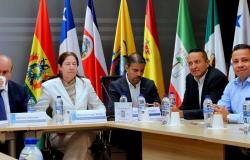
Although Governor Rafael Martínez stood them up in the socialization of the Hermandad bridge project, it was learned that $5.2 billion is required for the studies of phases 2 and 3, and that the work would have a total cost of $366,000 million. Work that will connect the departments of Atlántico and Magdalena.
Through a statement, the Atlántico government presented a detailed report on the progress of the Hermandad bridge project, a monumental work intended to connect the departments of Atlántico and Magdalena through a road complex between the district of Puerto Giraldo ( Ponedera, Atlántico) and the municipality of Salamina, Magdalena.
The event, held on May 18, was attended by several mayors of the riverside area of the department and the governor of Atlántico, Eduardo Verano, along with his work team. However, the notable absence was that of the governor of Magdalena, Rafael Martínez, who left the community and local leaders in the lurch, generating discontent among those attending.
The mayor of Salamina, Edwin Pavón, expressed his frustration at Martínez’s absence: “This project is very important, but we were missing the governor of Magdalena. All of us mayors are ready to work with him, but he has forgotten us. We mayors cannot do it alone, we need the governor. I send him a message: to put on your shirt, we are waiting for you here on the banks of the river, which is also part of the Magdalena.”
Even so, without the presence of Martínez in the socialization, the usefulness of a work that will facilitate the transit of people and goods nationwide, land communication, even to the departments of Bolívar and Cesar, and above all the development and the socioeconomic integration of the four departments and the Caribbean region in general.
According to the statement from the Atlántico government, the project contemplates four alternatives for the design of the bridge that have been classified according to their location.
The first alternative is located in the southern part of the study area; in the Atlantic it takes the Ferry road and part of the place where it begins; In the Magdalena it uses the current road to connect with route 2701. In the Atlantic it crosses through clean land.
The second alternative is located in the central part of the study area; located in the urban centers of Puerto Giraldo and Salamina. In Magdalena it connects with route 2702. A smaller number of properties are affected and they cross a smaller area of exclusion and restriction. There is no usable road on the route.
The first section of 1,200 meters corresponds to livestock-oriented properties, followed by a section of 900 meters that corresponds to crops; It crosses the river for a length of 1800 meters and is located in an exclusion zone. It also passes through a swampy area with wooded pastures that make it a restriction zone.
The third alternative is located in the northern part of the study area; in the Atlantic, it takes advantage of an existing road that has conditions for traffic; There is less property damage.
It is located in a very stable place on the river bank. The first 2500 meters cross pasture areas; It then crosses 1,200 meters of pasture, livestock, and secondary vegetation areas.
The crossing over the Magdalena River would be 1,490 meters, and between the viaducts and the bridge, the banks are located in a more stable manner. In the department of Magdalena it crosses a swampy area where temporary crops are found.
The fourth alternative is also located north of the study area. This route has no direct connection with route 2516 in the Atlantic. The first 1500 meters cross pastures and secondary vegetation; In the next 3100 meters it passes through environmentally sensitive areas, such as swamps that house aquatic and secondary vegetation. This is a restricted area. It crosses spaces of considerable environmental importance that must be protected.
According to the studies contracted by Invías, $5.2 billion are required to complete phases 2 and 3 of the studies, with a total estimated cost for the work of $366,000 million.
A representative of Invías ratified the benefits of the project during the socialization, highlighting its potential to transform the road and economic infrastructure of the region.
The community and leaders of the riverside municipalities hope that the completion of this project will significantly boost the development and integration of the departments involved, benefiting the entire Caribbean region.





